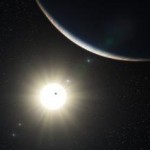We appear to be getting closer to discovering an earth like planet. We are not there yet, but are now knocking on the door of a discovery …
Astronomers using ESO’s world-leading HARPS instrument have discovered a planetary system containing at least five planets, orbiting the Sun-like star HD 10180. The researchers also have tantalising evidence that two other planets may be present, one of which would have the lowest mass ever found. This would make the system similar to our Solar System in terms of the number of planets (seven as compared to the Solar System’s eight planets). Furthermore, the team also found evidence that the distances of the planets from their star follow a regular pattern, as also seen in our Solar System.
It then goes on …
“We have found what is most likely the system with the most planets yet discovered,” says Christophe Lovis, lead author of the paper reporting the result. “This remarkable discovery also highlights the fact that we are now entering a new era in exoplanet research: the study of complex planetary systems and not just of individual planets. Studies of planetary motions in the new system reveal complex gravitational interactions between the planets and give us insights into the long-term evolution of the system.”
You can find the full article here.
The BBC also have picked this up and have a video report about it all on their website here.
This is indeed fascinating news, but it does beg a rather interesting question. HD 10180 is about 127 light years away from earth, so how the heck do you detect planets at that distance. Remember Carl Sagan’s “Pale Blue Dot”, the famous picture that shows earth as a tiny little dot from the outer fringes of our solar system? Well, what exactly do you use to go on a planet hunt when the distance is not just a hop across the solar system, but is 127 light years? Luckily the Daily Science article does explain …
The team of astronomers used the HARPS spectrograph, attached to ESO’s 3.6-metre telescope at La Silla, Chile, for a six-year-long study of the Sun-like star HD 10180, located 127 light-years away in the southern constellation of Hydrus (the Male Water Snake).
And so this does what?
HARPS is an instrument with unrivalled measurement stability and great precision and is the world’s most successful exoplanet hunter. Thanks to the 190 individual HARPS measurements, the astronomers detected the tiny back and forth motions of the star caused by the complex gravitational attractions from five or more planets.
What is even more exciting here is that in addition to the 5 planets, they also have reason to believe that there are two more. One would be approx 65 x Earth, but the other appears to be 1.4 x the size of earth. Now thats close, very close, and if correct would be the nearest to an Earth sized planet in another solar system ever found.
But don’t rush out to pack your bags yet, Virgin Galactic will not be heading that way. If the evidence is correct, and it is all confirmed, its very close to its parent star (just 2% of the Earth-Sun distance), so would be very hot indeed. Alas, too hot for life.
You can find out more about all this at the NASA Astronomy Picture of the day web site here.
